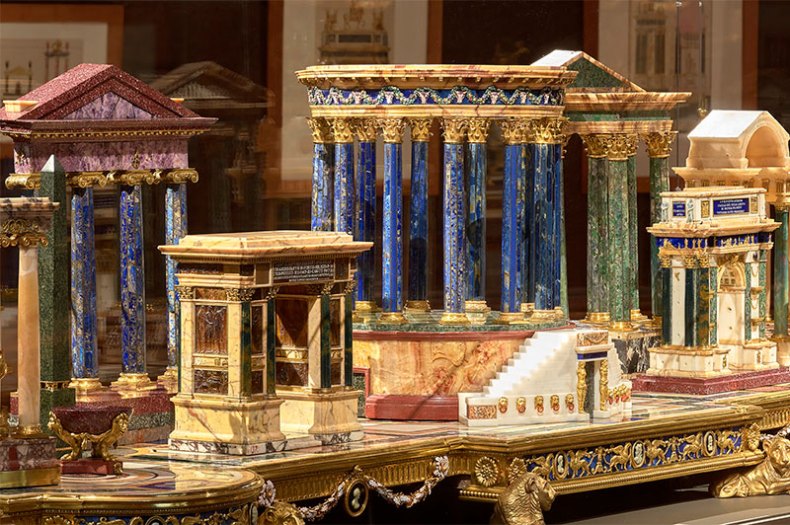It was inevitable, perhaps, that the Frick Collection in New York should follow its acclaimed show in 2016 on the virtuoso bronze chaser-gilder Pierre Gouthière with an exhibition devoted to his Roman counterpart and almost exact contemporary Luigi Valadier (1726–85). The key difference between the two is that while the Frenchman produced a limited number of pieces of superlative quality, predominantly for the French court, Valadier vaunted variety, masterminding the production on an almost industrial scale of a wide range of luxury goods that he supplied to the Church, the Roman aristocracy and Grand Tourists alike. At their most ambitious, his inventive, even whimsical designs are as spectacular as they are technically accomplished.
In contrast to the usual hierarchy of exhibition and accompanying catalogue, ‘Luigi Valadier: Splendor in Eighteenth-Century Rome’ offers a small but perfectly formed show to accompany a magisterial 560-page monograph (published in association with D. Giles Ltd). Its author, and the exhibition curator, is Alvar González-Palacios, the foremost authority on the subject. As one might expect, it is the first comprehensive study on the Valadier family, bringing new scholarship to archival research previously published in Italian or French and prompting, hardly less importantly, much needed new photography of many objects in situ.

Design for a Trembleuse (Digiuné) (before 1762), Luigi Valadier. Photo: Michael Bodycomb
Luigi Valadier was something of a polymath: a gifted draughtsman, designer, goldsmith, silversmith and bronze founder. But determining his precise contribution to the workshops’ productions is no straightforward business. He worked with his French-born father André (later Andrea) and for many years with his brother Giovanni, and his architect son Giuseppe, and oversaw 80 assistants and collaborators. Some 50 different hands may be detected in the hundreds of surviving drawings from the family workshops. Not a single bronze was signed, though happily some are documented. The fruits of González-Palacios’ painstaking detective work are evident here, but many of the signed designs, like that for a rococo-inspired trembleuse with a cup for chocolate and a beaker for water, are painful testimony to the huge quantities of – particularly secular – silver that have been lost.
Perhaps the most astonishing survival of ecclesiastical silver, and arguably the masterpiece of Roman goldsmiths’ art, is the monumental silver and gilt-metal High Altar of the Cathedral of Monreale, executed around 1768–73 (Sicily was spared a visit by Napoleonic forces). One of the triumphs of the Frick show is the loan of the cathedral’s six silver saints, each one standing over a metre high. The statues are usually too high and far away from the public gaze; this display allows close inspection, encouraging further debate on the authorship of the models. The jury is still out, but González-Palacios has come down firmly in favour of Luigi Valadier.

Installation view of deser for Jacques-Laure Le Tonnelier, Bailli de Breteuil (detail; c. 1778), Luigi Valadier. Patrimonio Nacional, Palacio Real, Madrid and Museo Arqueológico Nacional, Madrid. Photo: Michael Bodycomb
Most astounding, however, is the gathering of work made from precious and semi-precious hard and soft stones laid out in the Frick’s Oval Room. Valadier was astute in understanding that Rome’s classical legacy was both its past glory and present fortune, and for local aristocratic patrons as well as the visitors who flocked to the Eternal City he provided a microcosm of its archaeological glories – reduced-scale statues and vases but also miniature temples, exedrae, columns, obelisks and trophies reimagined in gloriously hued materials and executed in minute detail. Of all his extraordinary confections of porphyry, agate, jade, jasper, lapis lazuli, marble, crystal, enamels, silver-gilt, bronze and gems, none are perhaps more remarkable than the fantastical desers, or table-centres.
González-Palacios must be right in identifying Piranesi as their prime source, citing the likes of his Ideal Reconstruction of the Circus Maximus in which the artist embellished the central barrier of the oval chariot-racing circuit with tempietti, obelisks, columns, statuary, altars and the like. Centre-stage here are the elements of the second and most complete of the three Valadier desers, made in around 1778 and found languishing in obscurity in Madrid, divided between the Museo Arqueológico Nacional and the Palacio Real. Various (but not all) of its surviving constituent parts have been reunited for this exhibition, as have its related pen, ink and watercolour drawings.

The Triumph of Bacchus (1780), Luigi Valadier. Musée du Louvre, Paris. Photo: Les frères Chuzeville. © RMN-Grand Palais/Art Resource, NY
Alongside are presented Valadier’s lavish mounts, made for exceptionally large antique cameos in the Vatican. Inserted into the frame of The Triumph of Bacchus, which was excavated near Rome in 1661 and is now in New York on loan from the Louvre, are 30 gold-set gemstones and four further cameos. Like the Madrid deser, its rectangular panel rests on bronze lions that are reductions of ancient prototypes. Meanwhile, swimming in the waves of enamel paste on the alabaster base below are colourful marine creatures, again in semi-precious hardstones, ancient and modern. It is quite incredible.
Valadier’s were exceedingly costly productions, and like Gouthière, who went bankrupt, he suffered at the hands of clients who never or rarely paid their bills. In 1785, he died by drowning himself in the Tiber. Perhaps it was the worry over repaying the enormous sum of 10,000 scudi he had borrowed with a colossal interest rate of 24 per cent. We may never know, but this exuberant Frick show is a real treat and could hardly fail to lift the spirits.
‘Luigi Valadier: Splendor in Eighteenth-Century Rome’ is at the Frick Collection, New York, until 20 January 2019.
Unlimited access from just $16 every 3 months
Subscribe to get unlimited and exclusive access to the top art stories, interviews and exhibition reviews.














![Masterpiece [Re]discovery 2022. Photo: Ben Fisher Photography, courtesy of Masterpiece London](http://www.apollo-magazine.com/wp-content/uploads/2022/07/MPL2022_4263.jpg)
It’s time for the government of London to return to its rightful home